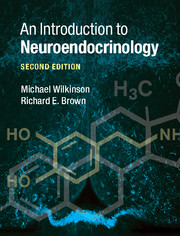Book contents
- Frontmatter
- Dedication
- Contents
- Preface to the second edition
- Acknowledgements
- List of abbreviations
- 1 Classification of chemical messengers
- 2 The endocrine glands and their hormones
- 3 The pituitary gland and its hormones
- 4 The hypothalamic hormones
- 5 Neurotransmitters
- 6 Neurotransmitter and neuropeptide control of hypothalamic, pituitary and other hormones
- 7 Regulation of hormone synthesis, storage, release, transport and deactivation
- 8 Regulation of hormone levels in the bloodstream
- 9 Steroid and thyroid hormone receptors
- 10 Receptors for peptide hormones, neuropeptides and neurotransmitters
- 11 Neuropeptides I: classification, synthesis and co-localization with classical neurotransmitters
- 12 Neuropeptides II: function
- 13 Cytokines and the interaction between the neuroendocrine and immune systems
- 14 Methods for the study of behavioral neuroendocrinology
- 15 An overview of behavioral neuroendocrinology: present, past and future
- Index
- References
15 - An overview of behavioral neuroendocrinology: present, past and future
Published online by Cambridge University Press: 05 June 2015
- Frontmatter
- Dedication
- Contents
- Preface to the second edition
- Acknowledgements
- List of abbreviations
- 1 Classification of chemical messengers
- 2 The endocrine glands and their hormones
- 3 The pituitary gland and its hormones
- 4 The hypothalamic hormones
- 5 Neurotransmitters
- 6 Neurotransmitter and neuropeptide control of hypothalamic, pituitary and other hormones
- 7 Regulation of hormone synthesis, storage, release, transport and deactivation
- 8 Regulation of hormone levels in the bloodstream
- 9 Steroid and thyroid hormone receptors
- 10 Receptors for peptide hormones, neuropeptides and neurotransmitters
- 11 Neuropeptides I: classification, synthesis and co-localization with classical neurotransmitters
- 12 Neuropeptides II: function
- 13 Cytokines and the interaction between the neuroendocrine and immune systems
- 14 Methods for the study of behavioral neuroendocrinology
- 15 An overview of behavioral neuroendocrinology: present, past and future
- Index
- References
Summary
The aim of this book
The aim of this book is to introduce students to the language and concepts of neuroendocrinology, including how the neuroendocrine system influences behavior. It began with a consideration of the many chemical messengers in the body, classified as “true” hormones, neurohormones, neurotransmitters, pheromones, parahormones, prohormones, growth factors, cytokines, adipokines, vitamins and neuropeptides. As more became known about the neuroendocrine system, it became clear that these classifications are not unambiguous and a single chemical might fit into two or more classes of messenger and perform different functions. This means that while the classification of chemical messengers is useful to begin the study of neuroendocrinology, by the end it provides little help in understanding the different actions of peptides, steroids, neuropeptides and neurotransmitters on different target cells, even within the same tissue.
The hormones of the endocrine and pituitary glands are generally accepted as the major components of the neuroendocrine system. However, the traditional endocrine function of hormones being released into the bloodstream to act on peripheral target cells represents only a small part of the neuroendocrine activity of hormones such as testosterone, cholecystokinin or somatostatin. These hormones also have significant effects in the brain, via specific receptors, and can alter neural regulation of autonomic reflexes, behavior and emotional states. The hypothalamus provides the link between the brain and the traditional endocrine system and provides the locus for external factors, such as environmental influences, to regulate endocrine target organs. Thus, while the endocrine system consists of a number of closed-loop feedback systems that maintain homeostatic control over the synthesis, storage, release and deactivation of hormones, external stimuli can alter these systems. For example, environmental stimuli, social interactions and cognitive factors can greatly alter the functioning of the endocrine system by altering the neurotransmitter/neuropeptide pathways that regulate the release of hypothalamic hormones.
- Type
- Chapter
- Information
- An Introduction to Neuroendocrinology , pp. 458 - 468Publisher: Cambridge University PressPrint publication year: 2015



